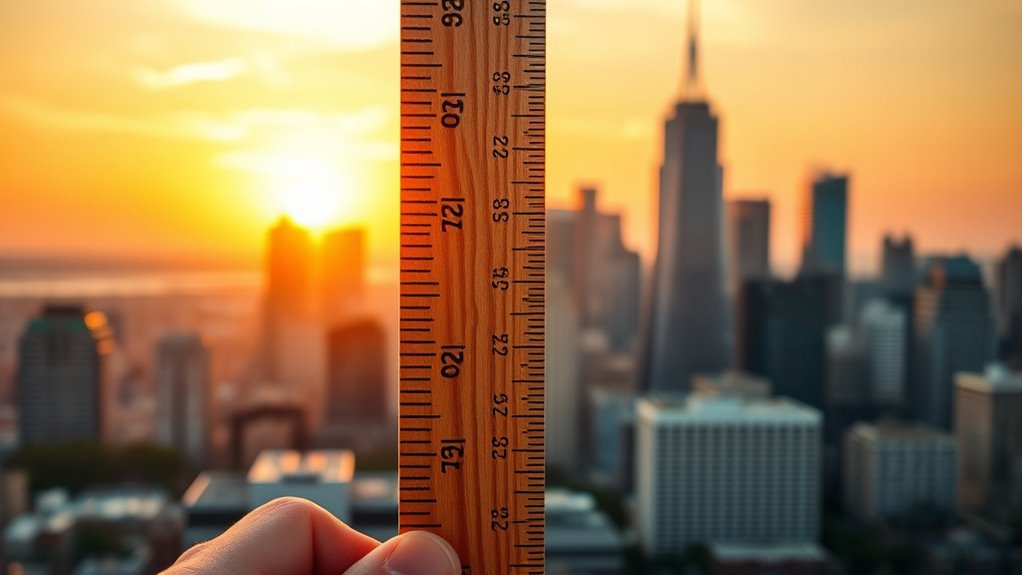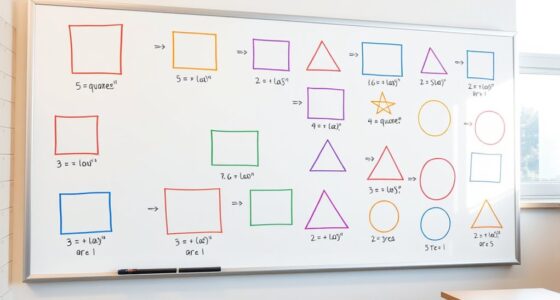You measure length in meters or feet because these units suit different needs and histories. The metric system, with meters, is simple and used worldwide, especially in science and most countries. Feet are common in everyday life in the U.S. and some other regions. Knowing why these units exist helps you communicate measurements clearly. If you want to understand how these systems compare and when to use each, there’s more to discover below.
Key Takeaways
- Different regions and contexts prefer specific units, like meters globally and feet mainly in the U.S.
- Meters are part of the metric system, which is decimal-based and simplifies conversions.
- Feet are traditional imperial units used in everyday measurements in certain countries.
- Understanding units helps ensure accurate communication and prevents measurement errors.
- Converting between meters and feet allows for effective international understanding and practical applications.

Have you ever wondered why we measure things the way we do? The answer lies in the measuring systems we’ve adopted over time and the significance of consistent units. Our everyday measurements—like length, weight, and volume—are based on standardized systems designed for clarity and ease of use. The most common measuring systems are the metric system and the imperial system. The metric system, which uses units like meters, centimeters, and kilometers, is widely adopted around the world because it’s decimal-based, making unit conversions straightforward. The imperial system, which includes feet, inches, and miles, is primarily used in the United States and some other countries. These systems influence how we measure length, and understanding their differences helps us communicate measurements accurately across contexts.
When you measure length, using the correct units depends on where you are and what you’re trying to accomplish. In science, the metric system reigns supreme because of its simplicity and universal acceptance. If you’re measuring the height of a building or the distance between two cities, meters or kilometers are your go-to units. Conversely, in everyday life in the U.S., you might measure a room’s dimensions in feet or inches. Recognizing these differences is essential because it impacts how measurements are understood and used. This is where unit conversions come into play. Converting between units—like changing feet to meters or inches to centimeters—is vital when working across different measuring systems. It ensures that measurements are consistent and meaningful, no matter what units you start with.
Understanding measuring systems and the process of unit conversions can seem intimidating at first, but once you grasp the basics, it becomes second nature. Imagine you’re planning a trip abroad and need to convert your height from feet to meters to fill out a form. Without knowing how to convert units properly, you might give an incorrect measurement, leading to confusion. Similarly, if you’re following a recipe or assembling furniture, knowing the right units and how to switch between them ensures accuracy and safety. The key is recognizing that all measurement systems are designed to serve specific needs, but they can be aligned through simple calculations. This understanding helps you avoid mistakes and communicate measurements clearly. Whether you’re working on a science project, traveling, or just trying to understand a map, knowing why we measure length in meters and feet—and being able to convert between them—empowers you to navigate the world with confidence.
Additionally, understanding the standardized measurement systems can help you make informed decisions in various practical situations, from home improvement projects to international travel.
Frequently Asked Questions
How Did the Meter Become the Standard Unit of Length?
You might find it fascinating that the meter became the standard unit of length through history evolution and measurement standards. In 1791, France established the meter based on Earth’s dimensions, aiming for a universal measurement system. Over time, international agreements like the 1960 General Conference on Weights and Measures refined it into the precise, scientific unit we use today. This standardization helps guarantee consistency across countries and industries worldwide.
Why Do Different Countries Prefer Meters or Feet?
You might think the world’s measurements are as simple as choosing sides, but cultural influences shape measurement preferences. Different countries prefer meters or feet because of historical ties, traditions, and practical needs. For example, the US sticks to feet due to legacy and familiarity, while most of the world uses meters because of international standards. These preferences reflect deep-rooted cultural influences that make measurement systems uniquely local, even in a globalized world.
Are There Other Units Used for Measuring Length Globally?
Yes, other units are used for measuring length globally. Historical measurement systems like inches, yards, and miles in the US and UK still influence everyday use. Cultural influences also shape preferred units, such as the Chinese using the chi or Japanese using the shaku. While meters are standard internationally, these traditional units remain common in daily life, reflecting a mix of history and culture in measurement practices around the world.
How Do Digital Devices Measure Length Accurately?
You might think digital devices struggle with accuracy, but they excel thanks to digital calibration and sensor accuracy. When you measure length, sensors detect precise distances by converting physical signals into digital data. This process guarantees consistent measurements, even in complex environments. By calibrating sensors regularly, devices stay accurate, allowing you to trust digital measurements for engineering, navigation, or everyday tasks, making precision seamless and reliable.
Can Units of Length Be Converted Into Other Measurement Systems?
Yes, you can convert units of length into other measurement systems through unit conversion. This process involves multiplying or dividing by a conversion factor, which relates one measurement system to another. For example, to switch from meters to feet, you multiply by the conversion factor 3.28084. Mastering unit conversion helps you compare and work with different measurement systems easily, ensuring accuracy regardless of the units used.
Conclusion
Now that you understand why we measure length in meters and feet, you see how these units help you compare, communicate, and navigate the world around you. You learn to appreciate the consistency they bring, the clarity they provide, and the convenience they offer. Whether you’re measuring a room or a race, knowing your units helps you measure accurately, understand clearly, and connect confidently. Embrace these units, and you’ll measure better, communicate clearer, and move smarter every day.







